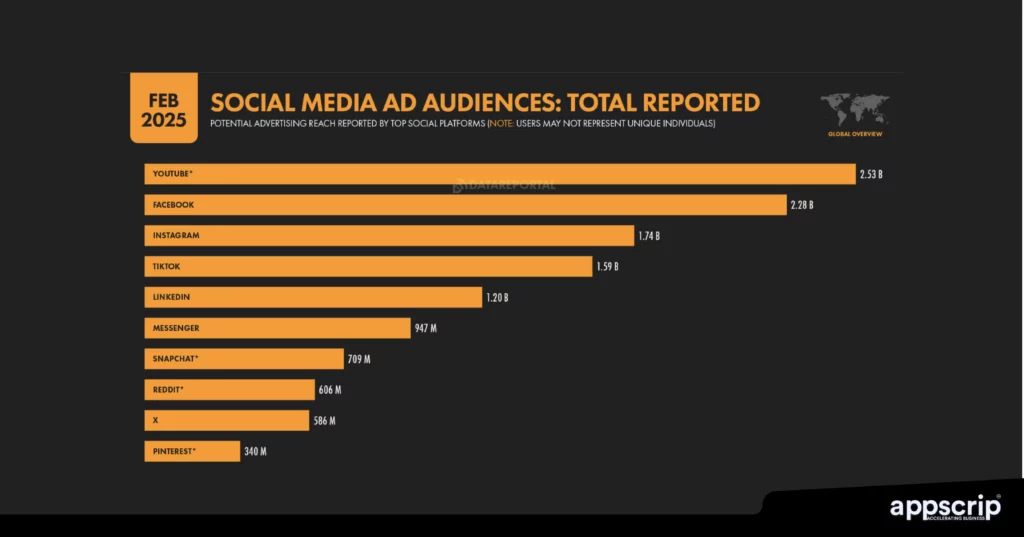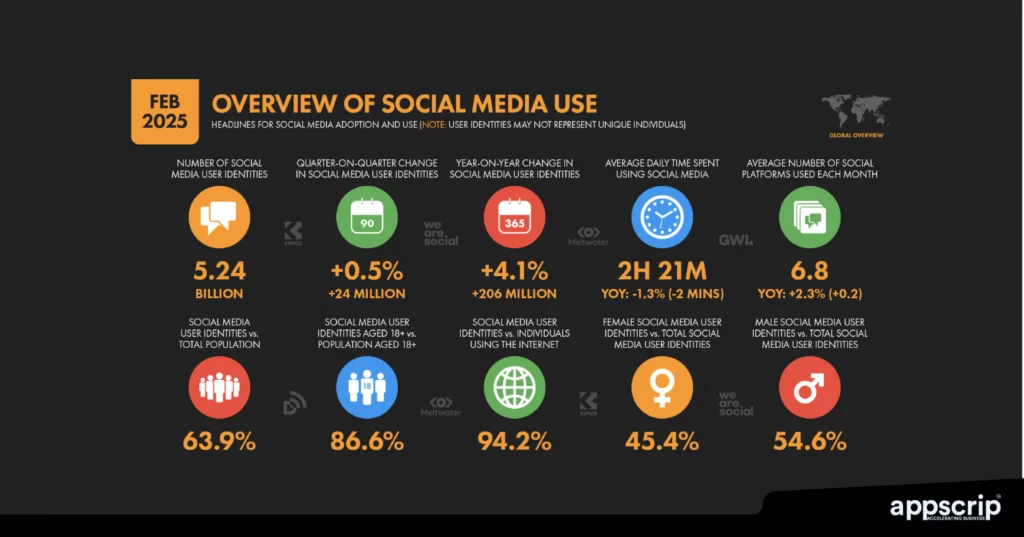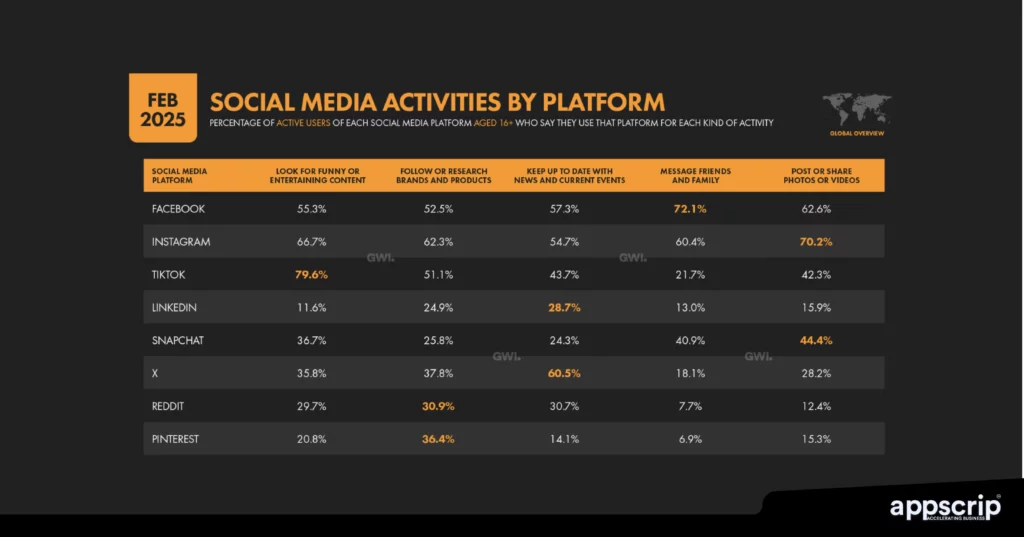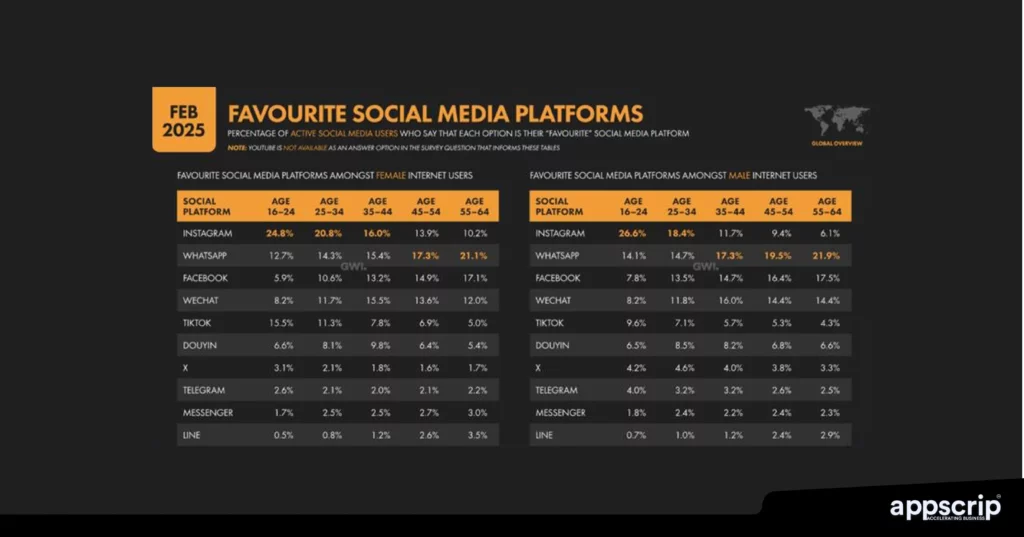The past decade has witnessed an unprecedented boom in the social media domain. What began as a mere platform for sharing photos and connecting with friends has evolved into a global phenomena that has percolated into every aspect of our lives.
Social media is no longer just an entertainment channel; it has become a powerful tool for businesses, influencers, and individuals to build communities, drive engagement, and foster meaningful connections.
Entrepreneurs and businesses must seize the opportunity to innovate and plan their foray into this lucrative domain.
TL;DR
- The social media boom has become a global spectacle, offering immense opportunities for startups.
- Current Trends: AI integration, authenticity, niche networks, and sustainability are key trends shaping the social media startup landscape in 2025.
- Challenges: Market saturation, user acquisition, monetization, and regulatory compliance are major hurdles for new entrants.
- Key Steps to Launch: Develop a unique value proposition, identify market gaps, build an MVP efficiently, and leverage plug-and-play solutions.
- Monetization Models: Explore in-app purchases, subscriptions, social commerce, and influencer marketing to create sustainable revenue streams.
- Accelerating Time-to-Market: Use pre-built scripts, agile development, outsourcing, and open-source technologies to speed up launch.
- Top Platforms to Watch: BeReal, Clubhouse & Twitter Spaces, Lemon8, Mastodon & Bluesky, Supernova, Quilt, and Cappuccino.
- Case Studies: Wombo, Torum, and Kumu Holdings are examples of successful social media startups that have carved out unique niches.
Understanding the Social Media Startup Landscape
Current Trends in Social Media Startups
Several key trends are shaping the social media startup environment in 2025:
Integration of Artificial Intelligence (AI)
AI is integrated into social media platforms to enhance user experience and engagement. xAI acquired the social media platform X for $45 billion with the aim to merge AI capabilities with social media functionalities, reflecting anticipation of AI dominance in the coming years.
Emphasis on Authenticity and Transparency
Users prefer platforms that promote genuine interactions and mitigate provocative content. Sez Us, a new social media app, penalizes those engaging in rage-baiting. They rate posts based on approval, influence, insightfulness, relevance, and politeness. This ensures a peaceful setting, reflecting the demand for authenticity in social media interactions.
Rise of Niche and Personalized Networks
There’s a shift towards niche and personalized social networks, indicating lack of interest in broad algorithm-driven platforms. Users seek communities that cater to specific interests that provide meaningful interactions.
Focus on Sustainability and Social Responsibility
Consumers prefer platforms that ensure sustainability and social responsibility. Startups that align with these values enhance their reputation and attract a dedicated user base. By 2025, 70+% of global consumers will choose, support, or boycott brands based on their response to social issues.

Challenges Faced by New Entrants
Despite the opportunities, social media startups encounter several challenges:
Market Saturation: The social media landscape is highly competitive, with numerous platforms vying for user attention. Differentiating your platform demands innovative features and a clear UVP.
User Acquisition and Retention: Attracting and maintaining a robust user base is key. Startups must invest in effective marketing strategies and continuously enhance user experience to foster loyalty.
Monetization Strategies: Developing sustainable revenue models is difficult. Balancing monetization with user satisfaction needs careful planning and execution.
Regulatory Compliance: Navigating the complex landscape of data privacy laws and content regulations is vital to escape legal pitfalls and build user trust.
Key Steps to Launching a Social Media Startups
Developing a Unique Value Proposition
In a cut-throat market, a compelling UVP will make all the difference you need. A strong UVP should provide answers to:
- What problem does your platform solve?
- How does it differ from other social networks?
- Why should users engage with you?
Identifying Market Gaps
To be successful businesses should aim to discover unfulfilled user needs. Market research will help find answers. You can even analyse existing platforms to locate areas of dissatisfaction or even emerging trends such as:
- Privacy-focused networks cater to those who are sick of data exploitation.
- Niche communities offer specialized content and engagement like social networks for artists, fitness enthusiasts, or tech professionals.
- AI-driven engagement tools that can personalize content as per user behaviour.
Building an MVP Quickly and Efficiently
To test the core concept, the best manner is through a Minimum Viable Product (MVP) using minimal resources. Once you are satisfied with the results, you can go in for full-scale development. Steps to build an MVP include:
- Defining Core Features – Your must-have features should showcase your UVP, like unique algorithms, engagement tools, or content-sharing mechanisms.
- Using Agile Development – An iterative process is a good idea to develop and refine the platform taking into consideration the user feedback.
- Beta Testing with Early Adopters – To gather insights and improve functionality, an MVP can be released to a small group of users.
- Measuring Key Metrics – There are important metrics to track like retention rates, engagement levels, and user feedback. These will help refine your product.

Leveraging Plug-and-Play App Solutions
Building from scratch may be a good idea, but has its own issues. Instead, startups can use ready-made solutions to enhance development and cut costs.
White-Label Platforms
Services like Mighty Networks and Disciple Media allow entrepreneurs to create branded social media apps with built-in community engagement tools.
API Integrations
Using APIs like Firebase for authentication, Agora for live streaming, or Stripe for payments enables faster development without really going in for custom solutions.
No-Code and Low-Code Development
Drag and drop interfaces like Bubble and Adalo, can be used by founders not too tech-savvy to create fully functional social media applications.
Monetization Models for Social Media Startups
Exploring In-App Purchases and Subscriptions
Freemium model has the highest adoption rates wherein basic access is free, but premium features come at a cost.
Subscription-Based Monetization
- Tiered Subscriptions: Tiered subscription helps users decide what is important to them. Hence offer different access levels, such as free, premium, and pro plans, each with different benefits.
- Ad-Free Experience: Ads in between streams are frustrating, some users are ready to pay to get them removed and enjoy an uninterrupted experience.
- Exclusive Content Access: Premium content from influencers, educators, or creators should ideally be provided at a subscription fee.
In-App Purchases
- Virtual Goods: You can do as TikTok and Snapchat to sell digital items such as stickers, emojis, and special effects to garner revenue.
- Boosting Services: Posts can be promoted for higher visibility. Users can also change background elements in their visuals to make their content stand out.
- NFTs and Digital Assets: Users can buy, sell or trade in digital collectibles using blockchain technology.
Social Commerce Opportunities
The combination of e-commerce and social media birthed social commerce making this combo a powerful revenue stream. With social commerce users can purchase directly within the platform, easing the buying process.
Shoppable Posts
- Shoppable posts help users buy featured products without leaving the app from platforms like Instagram and TikTok.
- A marketplace experience can be created within an app by startups by partnering with brands.
Influencer and Affiliate Marketing
- Influencers can use referral links to promote products and earn revenue through the sale they create.
- Brands can collaborate with content creators to develop an influencer marketplace.
Live Shopping Events
- Livestream shopping is growing in popularity. Now influencers and brands can showcase products in real-time and make users through FOMO.
- Social media startups can adopt sustainable business models while enhancing user engagement and satisfaction using these monetisation strategies.

Accelerating Time-to-Market
Strategies for Rapid Development and Launch
Change is a constant in the social media landscape, hence timing is everything and a quick launch is key. The faster you can launch, the more your chances of capturing early users and gaining traction are increased. To speed up development:
Use Pre-Built Scripts – Instead of coding from scratch, leverage platforms like Appscrip to build social media apps quickly with pre-designed, scalable solutions. Appscrip offers customizable app scripts for various social media models, cutting development time and investment significantly.
Agile Development Approach – Implement iterative development cycles, ensuring continuous improvements while keeping launch timelines within sight.
Outsourcing Development – Work with experienced developers or firms specializing in social media app creation to fast-track the process.
Leveraging Open-Source Technologies – Reduce costs and development time by utilizing open-source frameworks and tools to build your platform.
Importance of Early Traction and User Feedback
Launching quickly does not mean easy traction. To ensure long-term success, focus on:
Beta Testing & Soft Launches – An app needs to be introduced to a small audience to identify bugs, collect feedback, and refine user experience.
Community Building – To build a strong user base, get those early adopters through referral programs, exclusive content, or loyalty rewards.
Data-Driven Iterations – Analyse user behaviour regularly and use feedback to adapt features. Appscrip can integrate advanced analytics into your app, to understand and respond to user needs effectively.
Growth Hacking Strategies – Use proven marketing tactics, partnerships, and influencer collaborations to ensure quick adoption.
By leveraging pre-built solutions like Appscrip, startups can reduce development time, cut costs, and focus on what truly matters—gaining users and growing their platform.
Top Social Media Platforms for Startups
These are a few emerging platforms to watch out for:
Platforms to Watch in 2025
1. BeReal – The Rise of Authenticity
BeReal promotes unfiltered and raw content, challenging the heavily curated world of social media. The app asks users to post once a day when notified, capturing a photo using both the front and back cameras simultaneously.
- Why It’s Gaining Traction: People crave authenticity and real-life glimpses rather than made up realities.
2. Lemon8 – The Visual Content Fusion
A mix of Instagram and Pinterest, Lemon8 combines visually appealing content with community-driven engagement. This platform is for users who love aesthetic feeds and lifestyle inspiration.
- Why It’s Captivating Gen Z: Instagram has a commercial focus, while Lemon8 is more community-oriented and less pressured.
3. Mastodon & Bluesky – Decentralized Social Experiences
These challenge top social media giants by giving users more control over their data and content.
- Mastodon: An open-source, decentralized alternative to Twitter, where users can create their own communities with local moderation.
- Bluesky: Initiated by Jack Dorsey, it aims to decentralize social media and overcome corporate influence.
- Why They Matter: Concerns over data privacy and content moderation are pushing users to decentralized options.
4. Quilt – Community-Driven Wellness Conversations
Quilt is an audio social network centered around wellness and personal growth. Unlike Clubhouse and Twitter Spaces, Quilt specifically targets people looking to discuss mental health, personal development, and community well-being.
- Why It’s Unique: Focuses on supportive and uplifting conversations rather than just networking or content creation.

Case Studies of Successful Social Media Startups
Wombo: Pioneering Viral Deepfake Entertainment
Wombo brought in creative content sharing so that users could create and share lip-syncing videos, attracting a large user base. Wombo’s focus on user creativity and engagement has placed it among the leaders in the emerging deepfake entertainment space.
Torum: Building a Crypto-Driven Social Ecosystem
By offering token-based tipping and NFT staking, Torum built a community where users feel valued and induced them to participate. Torum made this possible by integrating DeFi and NFT features to create a unique social media experience to reward users for their contributions.
Kumu Holdings: Energizing Underserved Communities
Kumu focuses on interactive social streaming for underserved communities to connect and engage. Now, users can stream talent shows, sell products, and send virtual gifts, thus enabling economic opportunities for creators and fans alike.
Conclusion: Social Media Startups
Having an amazing social media startup idea and launching it in 2025 requires innovation, rapid execution, and smart monetization strategies. Key takeaways include:
- Develop a strong UVP that addresses a market gap.
- Build an MVP efficiently using pre-built solutions like Appscrip.
- Choose the right monetization model to ensure sustainability.
- Leverage growth hacking strategies for early traction.
- Stay updated on emerging platforms and trends.
By following these strategies, entrepreneurs can accelerate time-to-market and maximize success in the competitive social media landscape.





